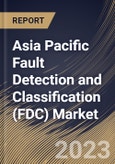FDC systems are increasingly integrating artificial intelligence and machine learning technologies. These technologies enhance fault detection accuracy by allowing systems to learn and adapt to complex manufacturing processes. Predictive analytics and pattern recognition have become essential components of modern FDC solutions. The Internet of Things (IoT) and Industry 4.0 initiatives continue to drive the market. IoT sensors and devices are being used to collect real-time data from various points in the manufacturing process, enabling more comprehensive fault detection and classification. FDC systems are deployed at the network's edge to lower latency and improve real-time decision-making. Edge computing permits faster data analysis and response, critical in applications requiring immediate action to prevent faults or defects.
Cloud computing is gaining traction in the market. Cloud-based FDC solutions offer scalability, flexibility, and accessibility. They allow manufacturers to store and analyze vast amounts of data from multiple locations and enable remote monitoring and management. A growing emphasis is on ensuring that FDC systems seamlessly integrate with other manufacturing systems and technologies. Interoperability and connectivity are crucial for creating a holistic and efficient manufacturing ecosystem. FDC systems are increasingly used to optimize energy consumption and decrease waste in manufacturing processes.
The Indian semiconductor sector is estimated to be worth about $23.2 billion in 2023 and is expected to grow to $80.3 billion by 2028, according to Invest India. India has increasingly focused on advanced manufacturing techniques like microelectronics and semiconductor fabrication. FDC is crucial in maintaining consistency and precision in these complex processes. The electronic and semiconductor industry in India is increasingly competitive on a national scale. FDC systems help Indian manufacturers maintain product quality, efficiency, and competitiveness in the market. The need for quality control, process optimization, and competitiveness drives the FDC usage in India's electronic and semiconductor sector. As the electronic and semiconductor industry continues to expand and innovate, the role of FDC systems in ensuring product quality and operational efficiency is expected to grow.
The China market dominated the Asia Pacific Fault Detection and Classification (FDC) Market by Country in 2022, and would continue to be a dominant market till 2030; thereby, achieving a market value of $917.3 million by 2030. The Japan market is showcasing a CAGR of 8.7% during (2023 - 2030). Additionally, The India market would register a CAGR of 10.2% during (2023 - 2030).
Based on Application, the market is segmented into Manufacturing, and Packaging. Based on Component, the market is segmented into Hardware (Cameras, Sensors & Processors, Frame Grabbers, and Others), Software, and Services. Based on End-use, the market is segmented into Electronics & Semiconductors, Automotive, Metals & Machinery, Food & Packaging, and Others. Based on countries, the market is segmented into China, Japan, India, South Korea, Singapore, Malaysia, and Rest of Asia Pacific.
The market research report covers the analysis of key stake holders of the market. Key companies profiled in the report include Applied Materials, Inc., KLA Corporation, Siemens AG, Microsoft Corporation, Amazon Web Services, Inc, Tokyo Electron Ltd., OMRON Corporation, Teradyne, Inc., Cognex Corporation and Advantest Corporation.
Scope of the Study
Market Segments Covered in the Report:
By Application- Manufacturing
- Packaging
- Hardware
- Cameras
- Sensors & Processors
- Frame Grabbers
- Others
- Software
- Services
- Electronics & Semiconductors
- Automotive
- Metals & Machinery
- Food & Packaging
- Others
- China
- Japan
- India
- South Korea
- Singapore
- Malaysia
- Rest of Asia Pacific
Key Market Players
List of Companies Profiled in the Report:
- Applied Materials, Inc.
- KLA Corporation
- Siemens AG
- Microsoft Corporation
- Amazon Web Services, Inc
- Tokyo Electron Ltd.
- OMRON Corporation
- Teradyne, Inc.
- Cognex Corporation
- Advantest Corporation
Unique Offerings
- Exhaustive coverage
- The highest number of Market tables and figures
- Subscription-based model available
- Guaranteed best price
- Assured post sales research support with 10% customization free
Table of Contents
Companies Mentioned
- Applied Materials, Inc.
- KLA Corporation
- Siemens AG
- Microsoft Corporation
- Amazon Web Services, Inc
- Tokyo Electron Ltd.
- OMRON Corporation
- Teradyne, Inc.
- Cognex Corporation
- Advantest Corporation








